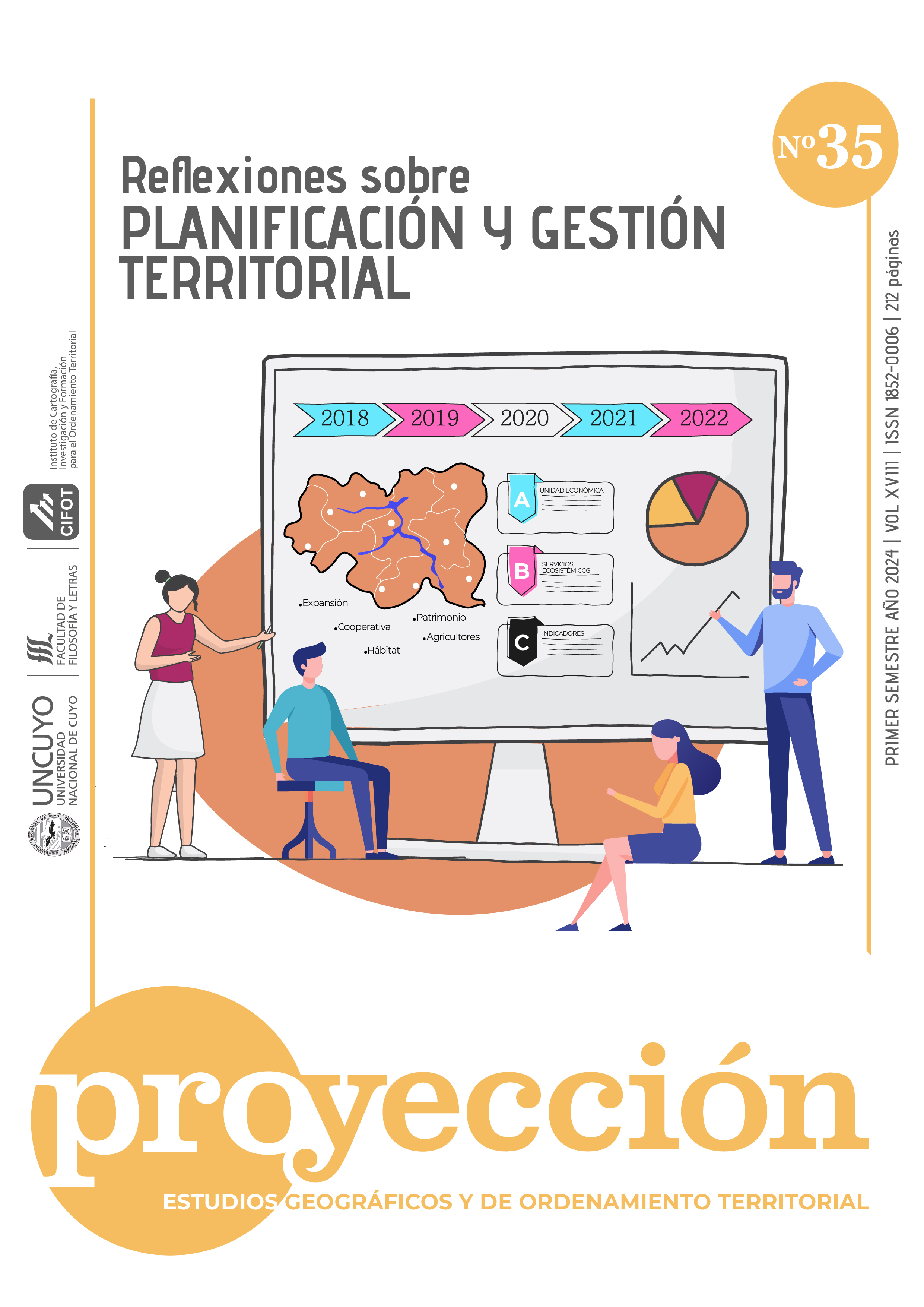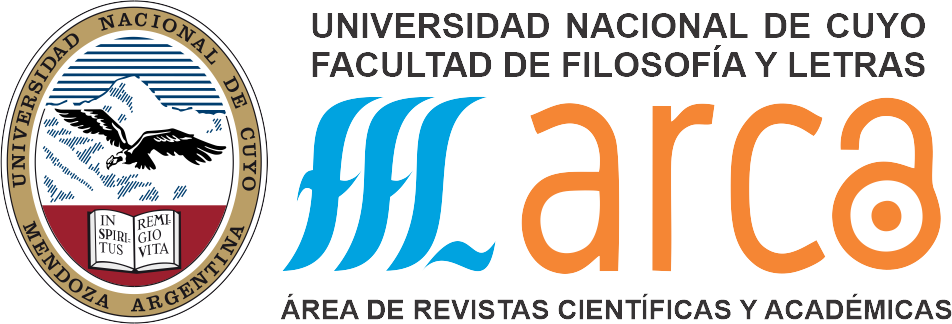Spatial Indicators of Biological Diversity in the Construction of Land Use Planning Instruments.
The Cases of Mendoza and Córdoba in Argentina
DOI:
https://doi.org/10.48162/rev.55.059Keywords:
Climate change, urbanization, biodiversity, remote sensing, intermediate citiesAbstract
The study focuses on the impact of urban growth and expansion on surrounding areas. It emphasizes the recent changes in the city's complex system and its utilization of land for various purposes. Intermediate cities play a crucial role in dealing with the effects of climate change, so it's important to develop plans that organize the urban and rural areas. The construction and implementation of land-use planning instruments that organize these territories is urgent. This study aimed to ascertain the significance of these dynamic cities in testing biodiversity-based planning tools within the context of climate change. It includes two case studies: Córdoba and Mendoza. Remote sensing techniques were employed to accurately assess vegetation in the rural areas surrounding both cities. The findings were then meticulously compared with comprehensive land cover maps. The study concluded that areas exhibiting high vegetation productivity also boasted rich biodiversity and were in close proximity to the urban center.
References
Abramo, P. (2012). La ciudad com-fusa: Mercado y producción de la estructura urbana en las grandes metrópolis latinoamericanas. Eure, 38(114), 35–69. https://doi.org/10.4067/S0250-71612012000200002
Ascher, F. (2004). Los nuevos principios del urbanismo. El fin de las ciudades no está a la orden del día. Madrid: Alianza.
Atwoli, L., Baqui, A. H., Benfield, T., Bosurgi, R., Goglee, F., Hancocks, S., … Vázquez, D. (2021). Call for emergency action to limit global temperature increases , restore biodiversity , and protect health. The Lancet, 398, 939–941. https://doi.org/10.1016/S0140-6736(21)01915-2
Bárcena, A., Samaniego, J., Peres, W., & Alatorre, J. E. (2020). La emergencia del cambio climático en América Latina y el Caribe ¿Seguimos esperando la catástrofe o pasamos a la acción? (CEPAL, Ed.). Santiago: Naciones Unidas.
Brenner, N. (2013). Tesis sobre la urbanización planetaria. Nueva Sociedad, (243), 38–66.
Céliz, Y. (2020a). Transformaciones en territorios de interfase. Un aporte a la planificación en Córdoba desde los socioecosistemas. Universidad Nacional de La Plata.
Céliz, Y. (2020b). Una construcción compleja de la interfase territorial. Revisión conceptual para la generación de variables de análisis. Papeles de Geografía, 66(2020), 151–176. Retrieved from https://revistas.um.es/geografia/article/view/411721/300551
CEPAL (2010). La economía del cambio climático en América Latina y el Caribe: algunos hechos estilizados.
Consejo de Europa (2000). European landscape convention. European Treaty Series, 176, 1-7.
Chomitz, K. M., Buys, P., & Thomas, T. S. (2005). Quantifying the rural-urban gradient in Latin America and the Caribbean. World Bank Policy Research Working Paper 3634.
Chuvieco, E. (1995). Fundamentos de teledetección espacial. p. 415. Madrid: Ediciones RIALP S.A.
Cicolella, P. (2014). Metrópolis Latinoamericanas. Ciudad Autónoma de Buenos Aires: Café de las Ciudades.
European Commission, Directorate-General for Environment, (2014). Building a green infrastructure for Europe, Publications Office. https://data.europa.eu/doi/10.2779/54125
Fensholt, R., Sandholt, I., Schultz, M., Stisen, S., & Diouf, A. (2006). Evaluation of satellite based primary production modelling in the semi-arid Sahel. Remote Sensing of Environment, 105, 173–188. https://doi.org/10.1016/j.rse.2006.06.011
Galindo, C., & Delgado, J. (2006). Los espacios emergentes de la dinámica rural-urbana. Problemas Del Desarrollo. Revista Latinoamericana de Economía, 1–2.
García, C., Teich, I., Kindgard, A., Bosio, M. J., Ravelo, A., Piumetto, M., … Fuentes, M. L. (2018). Mapas de cobertura del suelo de la provincia de córdoba 2017/2018 (p. 64). p. 64. Córdoba: Infraestructura de Datos Espaciales de Córdoba (IDECOR).
Hilgert, N. I., Stampella, P. C., Pochettino, M. L., & Hernández Bermejo, J. E. (2022). Las Misiones del Noreste Argentino.
IGN-SegemAR. (2021). Definición de áreas de montaña de la República Argentina de la parte continental americana e Islas Georgias del Sur. Ciudad Autónoma de Buenos Aires.
Isgró M., Gatti A., Grintal M., Kolton F., Milone M., Morgani R., Poppi M., Pravatta L. (2019). Plan Municipal de Ordenamiento Territorial de Mendoza. https://ciudaddemendoza.gob.ar/wp-content/uploads/ 2019/04/PMOT.pdf
Jaillet, M., & Jalabert, G. (1982). La production de l’espace urbain périphérique. Revue Géographique Des Pyrénées et Du Sud-Ouest, 53(1), 7–26. https://doi.org/10.3406/rgpso.1982.3672
Justice, C. O., Townshend, J. R. G., Holben, B. N., & Tucker, C. J. (1985). Analysis of the phenology of global vegetation using meteorological satellite data. International Journal of Remote Sensing, 6(8), 1271–1318.
Krellenberg, K., Welz, J., Link, F., & Barth, K. (2016). Urban vulnerability and the contribution of socio-environmental fragmentation : Theoretical and methodological pathways. Progress in Human Geography, 1–24. https://doi.org/10.1177/0309132516645959
Liu, J., Dietz, T., Carpenter, S. R., Folke, C., Alberti, M., Redman, C. L., … Provencher, W. (2007). Coupled human and natural systems Coupled Human and Natural Systems. Ambio, 36(8), 639–649.
Llop, J. M., Iglesias, B. M., Vargas, R., & Blanc, F. (2019). Las ciudades intermedias : concepto y dimensiones. Ciudades, 22(2019), 23–43. https://doi.org/https://doi.org/10.24197/ciudades.22.2019.23-43
Magrın, G., Gay Garcıa, C., Cruz Choque, D., Giménez, J. C., Moreno, A. R., Nagy, G. J., ... & Villamizar, A. (2007). Latin America. Climate change 2007: impacts, adaptation and vulnerability. Contribution of Working Group II to the Forth Assessment Report of the Intergovernmental Panel on Climate Change. Cambridge University Press, Cambridge, 581-615.
Magrin, G. O., Marengo, J. A., Boulanger, J. P., Buckeridge, M. S., Castellanos López, E. J., Poveda, G., ... & Villamizar, A. (2014). Central and South America. In Climate Change 2014: Impacts, Adaptation and Vulnerability. Part B: Regional aspects. (pp. 1501–1545).
Márquez, G. (1997). Ecosistemas como factores de bienestar y desarrollo. Ensayos de Economía, 7(13), 113–141. Retrieved from https://revistas.unal.edu.co/index.php/ede/article/view/23828/24511
Milesi, C., Elvidge, C. D., Nemani, R. R., & Running, S. W. (2003). Assessing the impact of urban land development on net primary productivity in the southeastern United States. Remote Sensing of Environment, 86, 401–410. https://doi.org/10.1016/S0034-4257(03)00081-6
Millennium Ecosystem Assessment. (2005). Ecosystems and human well-being: A framework for assessment. Washington DC.
Ministerio del Interior Obras Públicas y Viviendas. (2018). Política Nacional Urbana Argentina. Buenos Aires.
Naciones Unidas (2015). World Urbanization Prospects: The 2014 Revision, (ST/ESA/SER.A/366). Departamento de asuntos económicos y sociales, División Población.
Naciones Unidas (2016). Conferencia temática previa a Hábitat III “Ciudades intermedias: crecimiento y renovación urbana”. Cuenca noviembre de 2015.
Naciones Unidas. (2018). La Agenda 2030 y los Objetivos de Desarrollo Sostenible. Una oportunidad para América Latina y el Caribe. Santiago.
ONU HABITAT. (2011). Las ciudades y el cambio climático: orientaciones para políticas. Informe mundial sobre asentamientos humanos 2011. Kenia.
ONU HABITAT. (2020). La Nueva Agenda Urbana (Programa d). Nairobi GPO Kenya.
Paruelo, J M. (2008). La caracterización funcional de ecosistemas mediante sensores remotos. Ecosistemas, 17(3), 4–22.
Paruelo, José M, Golluscio, R. A., Guerschman, J. P., Cesa, A., Jouve, V. V, & Garbulsky, M. F. (2004). Regional scale relationships between ecosystem structure and functioning : the case of the Patagonian steppes. Global Ecology and Biogeography, (13), 385–395.
Paruelo, José M, Guershman, J. P., Piñero, G., Jobbágy, E. G., Verón, S. R., Baldi, G., & Baeza, S. (2006). Cambios en el uso de la tierra en Argentina y Uruguay : marcos conceptuales para su análisis. Agrociencia, 10(2), 47–61.
Paruelo, José M, Texeira, M., Staiano, L., Mastrángelo, M., Amdan, L., & Gallego, F. (2016). An integrative index of Ecosystem Services provision based on remotely sensed data. Ecological Indicators, 71, 145–154. https://doi.org/10.1016/j.ecolind.2016.06.054
Peralta, C. (2018). Urbanización y redistribución espacial de la población de la provincia de Córdoba 1914-2010 (Universidad Nacional de Córdoba). Retrieved from https://rdu.unc.edu.ar/handle/ 11086/6845
Pírez, P. (2016). Las heterogeneidades en la producción de la urbanización y los servicios urbanos en América Latina. Territorios, 34(I), 87–112.
Rojas, F., Rubio, C., Rizzo, M., & Bernabeu, M. (2020). Land Use and Land Cover in Irrigated Drylands : a Long-Term Analysis of Changes in the Mendoza and Tunuyán River Basins , Argentina ( 1986 – 2018 ). Applied Spatial Analysis and Policy, 25. https://doi.org/https://doi.org/10.1007/s12061-020-09335-6
Rossman, L.A. (2010). Storm water management model user’s manual, version 5.0, National Risk Management Research Laboratory, Office of Research and Development, US Environmental Protection Agency.
Schmitt, T., Billah, M., Collins, J., Sullivan, M., & Busiek, B. (2010). EPAs response to the current status of CSO control efforts development of new tools and guidance. Proceedings of the Water Environment Federation, 2010, 1399–1405.
Shlomo, A., Parent, J., Civco, D. L., & Blei, A. M. (2012). Atlas of Urban Expansion. Cambridge Massachusetts: Lincoln Institute of Land Policy.
Soja, E. W. (2008). Postmetrópolis (Primera ed; Traficante de Sueños, Ed.). Madrid.
Tucker, C. J. (1979). Red and photographic infrared linear combinations for monitoring vegetation. Remote Sensing of Environment, (8), 127–150.
Wahren, P. (2020). Historia de los cambios tecnológicos en el agro argentino y el rol de las firmas multinacionales. Ciclos, XXVII(54), 65–91.
Wang, H. H., & Grant, W. E. (2021). Reflections of two systems ecologists on modelling coupled human and natural (socio-ecological, socio-environmental) systems. Ecological Modelling, 440(May 2020), 2–9. https://doi.org/10.1016/j.ecolmodel.2020.109403
Young, R. F., & McPherson, E. G. (2013). Governing metropolitan green infrastructure in the United States. Landscape and urban planning, 109(1), 67-75.
Downloads
Published
How to Cite
Issue
Section
License
Copyright (c) 2024 Yuliana Céliz

This work is licensed under a Creative Commons Attribution-NonCommercial-ShareAlike 3.0 Unported License.
La revista Proyección establece las siguientes condiciones de publicación para los/as autores/as:
- Los/as autores/as conservan los derechos de autor y ceden a la revista el derecho de publicación bajo la Licencia Creative Commons Atribución-No Comercial-CompartirIgual 3.0 No portada (CC BY-NC-SA 3.0) que permite a terceros copiar, distribuir, exhibir y ejecutar la obra citando siempre la fuente y los datos de autoría según la norma prevista por la Revista Proyección. Esta licencia no permite el uso de la obra con fines comerciales.
- Todos los trabajos publicados por Proyección, Estudios Geográficos y de Ordenamiento Territorial serán bajo la modalidad de gratuidad para autores/as y lectores/as.










